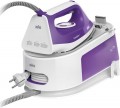Steam pressure
The maximum steam pressure provided by the iron in constant steam mode. The higher the steam pressure, the better the iron handles with thick fabrics that are poorly permeable to moisture. Note that most modern irons have a steam boost function — in this mode, the steam pressure almost doubles for a short time. Therefore, for domestic use, in most cases, a pressure of 3-4 bar will be sufficient, such irons can easily cope with ordinary fabrics, and for especially thick ones, you can use a steam boost. But in the professional field, it is recommended to use models with more powerful steamers.
Steam boost power
The steam power supplied by the iron in boost mode.
The steam power is the amount of steam the iron produces per minute. See above for more information on the general meaning of this parameter. And the steam boost mode is a mode of enhanced steaming, when the iron practically “shoots” with a boost of steam; "shot" is usually made by pressing a special button. Steam boost allows you to achieve an intense effect that is not available with conventional steaming; such an impact can be useful, for example, to smooth out heavily rumpled fabrics that would be difficult to deal with in other ways.
A steam boost of 100 g/min or more is said to be sufficient to handle most tough and "unruly" materials. And
models with a powerful steam boost from 200 g/min will definitely not leave even the most dense fabric rumpled. However, there are models with more modest indicators — they are quite suitable for those who need an iron for ordinary household ironing. Moreover, high power, usually, affects the cost. Do not forget about irons with a steam generator, where the performance values are higher, since the purpose of the iron is slightly different.
Water tank volume
The volume of the water tank installed in the iron.
The water from this container is used to generate steam when steaming fabrics. In modern models of irons, the tanks are made of transparent materials and are provided with a lid at the opening through which water is poured. As for capacity, a large volume, on the one hand, allows you to work longer without refilling, on the other hand, it significantly makes the entire device heavier. Therefore, in classic models, where the tank is located on the iron itself, the capacity is usually small — about 80 ml for travel and 300 ml for household models. But there are also
irons with a large water tank, in which the volume can reach 500 ml. But for advanced steam generators and ironing systems (see "Type"), the tank is made separately, and in such cases its volume can be 1 L, and for
models with a large tank, figures of more than 1.5 L are typical.
Steam hose length
The length of the steam hose from the steam generator to the iron.
The longer the hose, the farther you can reach without moving the device itself. On the other hand, a large length can create inconvenience during storage and transportation, as well as when working at short distances.
Cable length
The length of the cable for connecting to the mains provided in the iron.
Manufacturers select the length of the cable, taking into account the general specialization of the iron and the characteristics of its application — so that the wire is enough for most cases and at the same time it is not too long and bulky. Therefore, in most cases, this parameter can be ignored; exceptions are only some specific situations. For example, if you choose a travel iron and compactness is a key criterion, you should choose a
shorter wire. A
long cable, in turn, will come in handy at a great distance from sockets and the absence of extension cords.
For clarity, we note that for household irons, the average cable length is 1.5 m.
Iron weight
The total weight of the iron. Usually, this parameter is indicated "dry", without water; and for steam generators and ironing systems (see "Type"), the weight of the iron is given, without additional equipment.
Initially, it was believed that the heavier the iron, the more efficiently it performs its task. However, modern models use various technical tricks to achieve good ironing quality with low weight. At the same time, a lighter iron is more “manoeuvrable” and easier to use, you can work with it for a long time without getting tired. Therefore, it makes sense to specifically look for a massive model only in cases where you plan to often work with difficult-to-iron, “unruly” fabrics — for example, natural linen: more weight will give additional processing efficiency.



